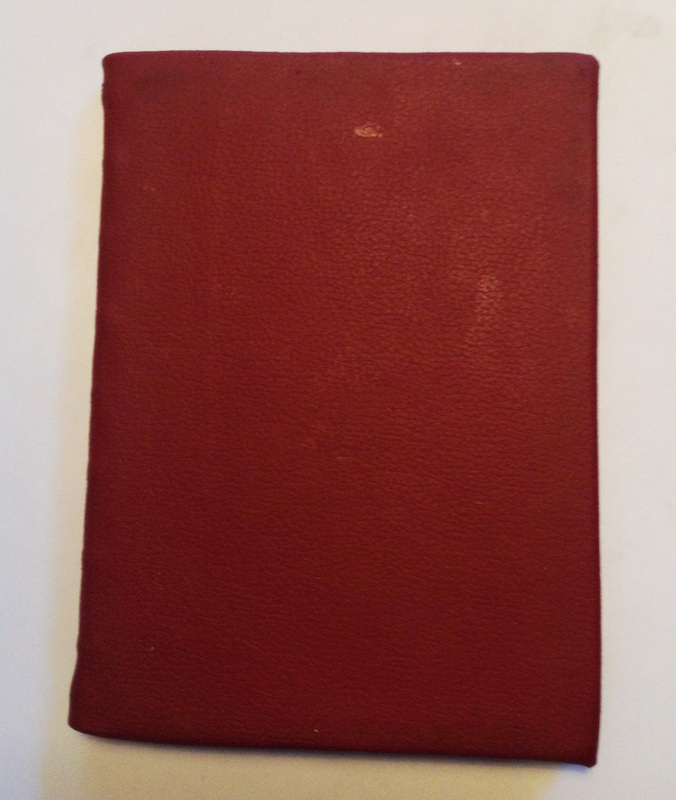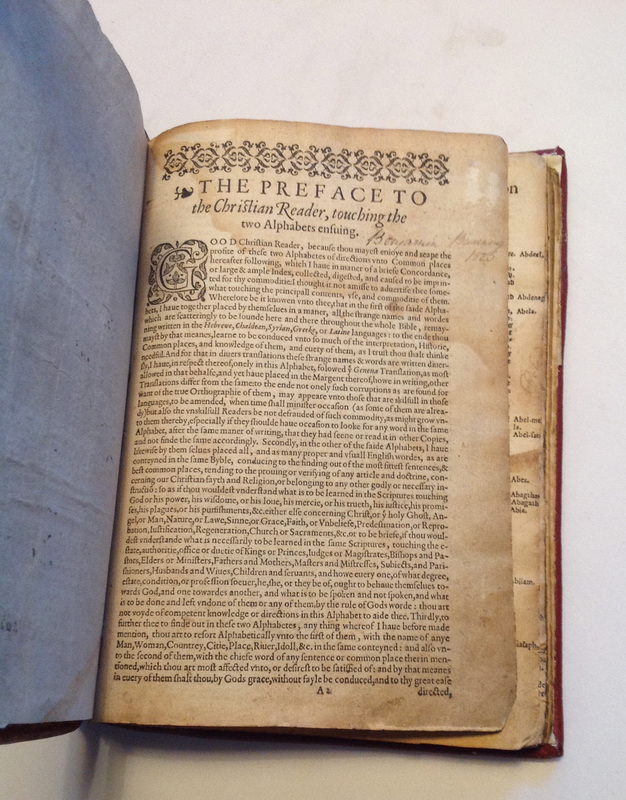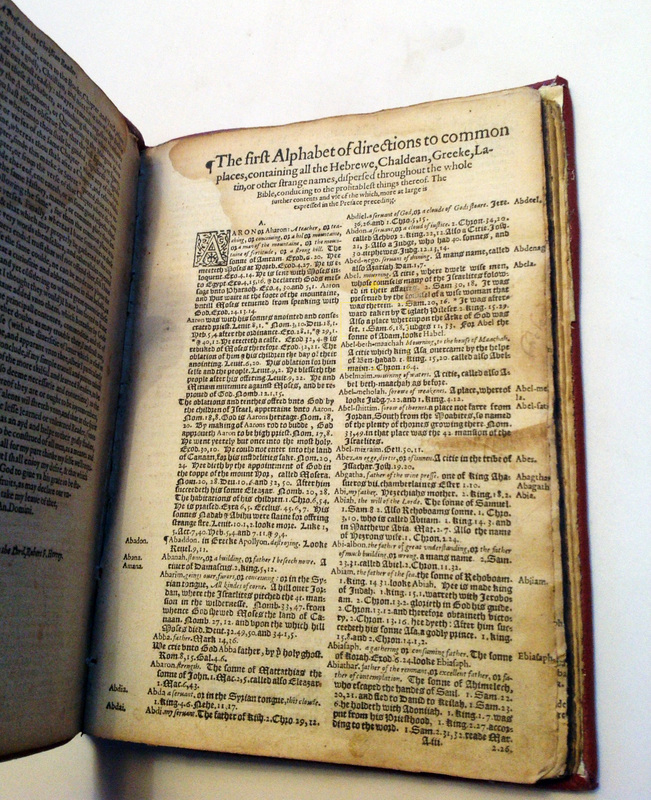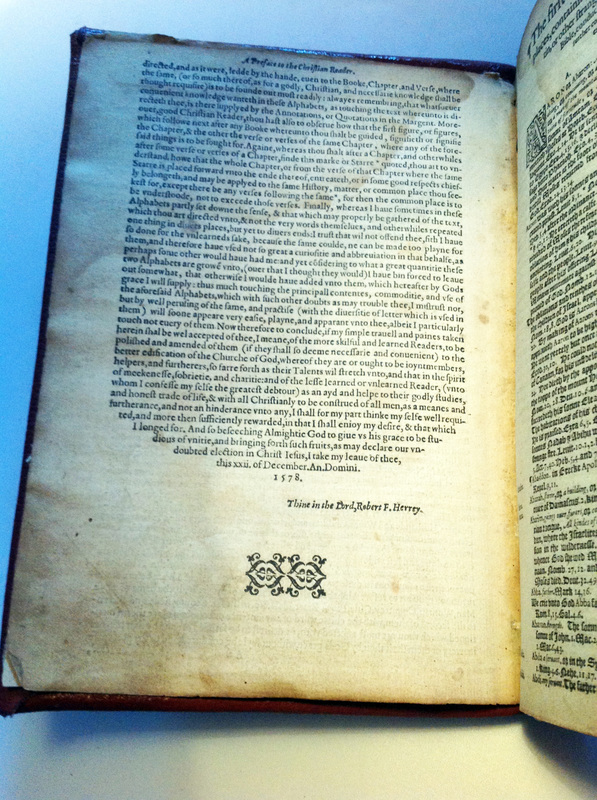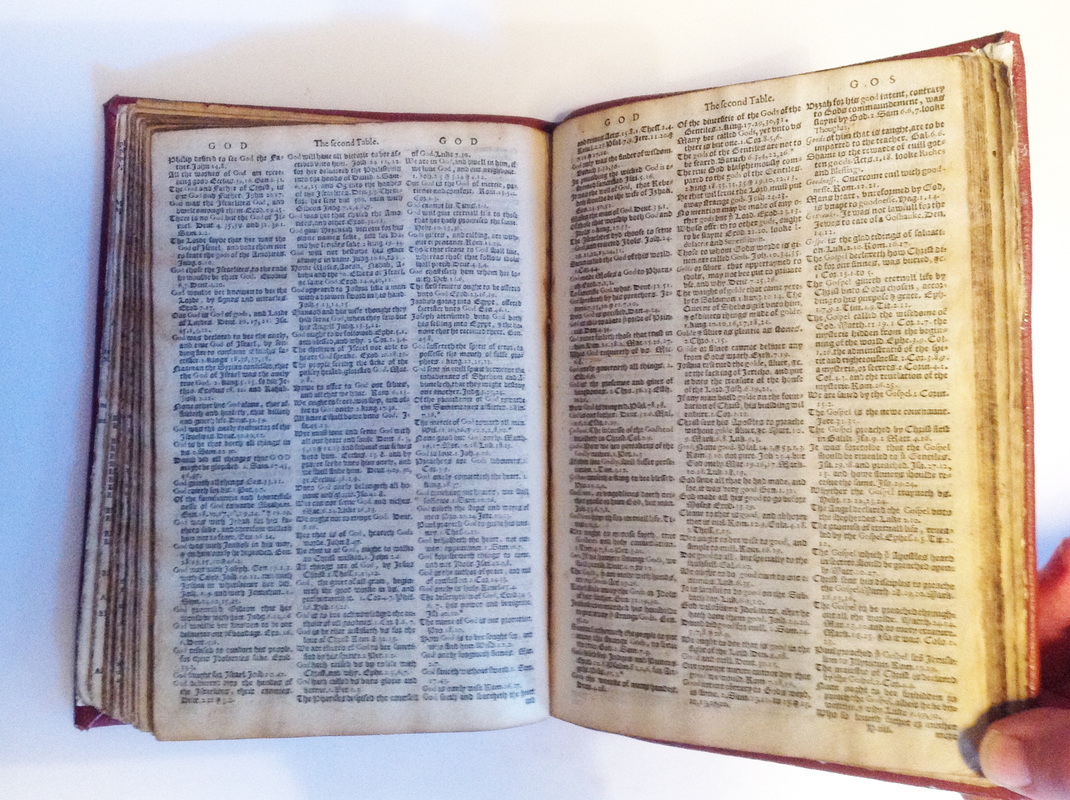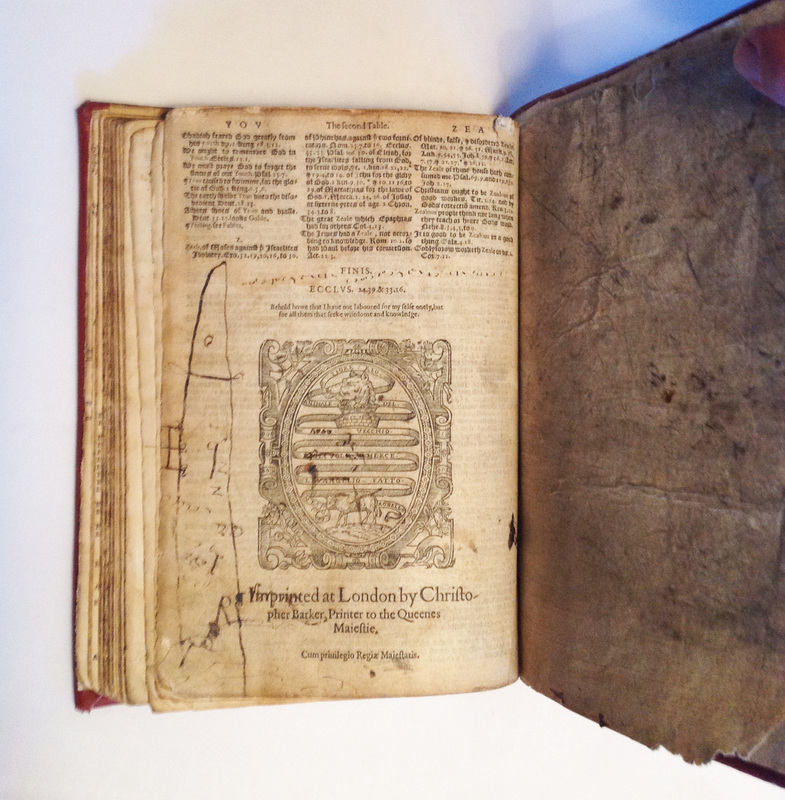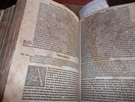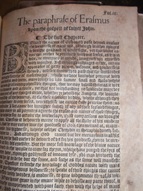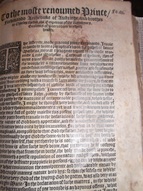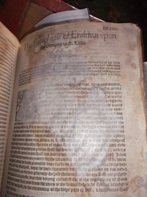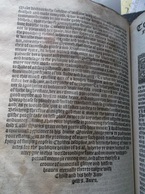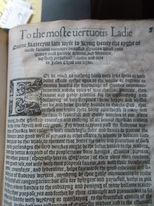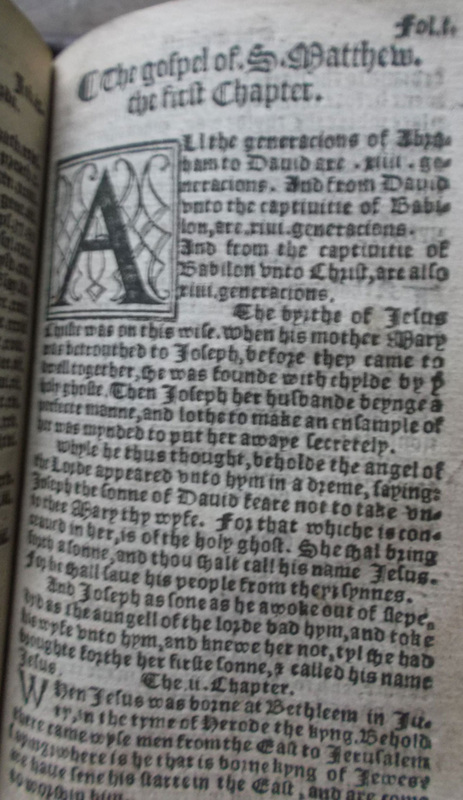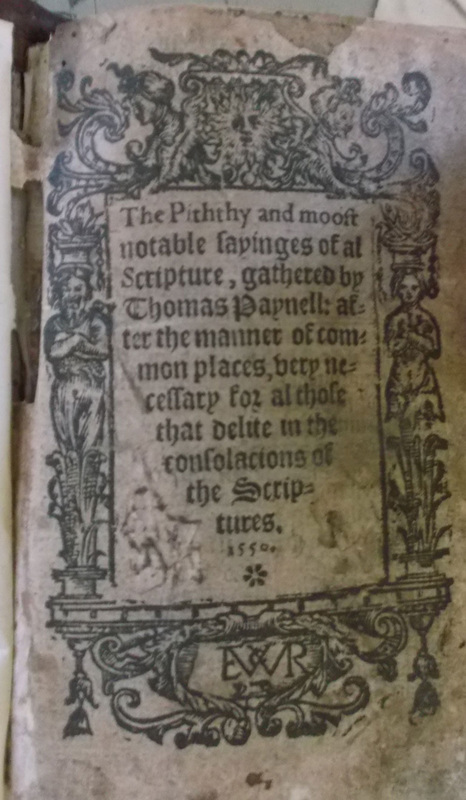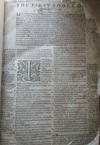16th. Century Bibles and Concordance
The Concordance;- 1578
Two right profitable and fruitfull Concordances, The “First” Alphabet of directions to common places, containing all the Hebrewe, Caldean, Greeke and Latin words, and names scatteringly dispersed throughout the whole Bible, with their common places following every of them. And the “Second” comprehending all such other principall words and matters, as concerne the sense and meaning of the Scriptures, or direct unto any necessary and good instruction.
Published in London : By Christopher Barker, printer to the Queenes most excellent Maiestie, [1578] This 1st. edition was printed as a separate Book by Christopher Barker in 1578 with a forward by the Author Robert F. Herrey.;- With 92 Pages;- According to A Short-Title Catalogue of Books 1475-1640 by A.W. Pollard & G.R.Redgrave, The Concordance, Begins on A2 With the opening page “ The Preface to the Christian Reader, touching the two Alphabets ensuring”. The Date 1578 is on the second page;- above, “Thine in the Lord, Robert F. Herrey.” Then the Concordance started to be published by Christopher Barker and Family two years later, in all Geneva Bibles of 1580 to 1615. Re-bound in Burgundy red leather, in good collectable condition. The Concordances is Complete, Part One & Two. No other copies of the year of 1578 are held in C.O.P.A.C. or any other Institutional Libraries in the World, so this is the only true 1st. Edition Copy found. Later editions 1580 or later are in some Libraries. The Imprinted at London : by the Christopher Barker, Printer to the Queenes most excellent Maiestie. Christopher Barker Printer’s device to the final page. The Barker Family printer most of the English Bibles. Christopher Barker the father of a printing dynasty. A concordance is an index. The idea is simple. Look up a word in the index and see a list of pages where the word occurs in the book. In the Bible concordance the list is of chapters and verses rather than pages. For example, look up "begat" in a Concordance of the Authorised or King James Version of the Bible and find that "begat" is listed 228 times in 142 verses if the three citations in the Apocrypha are included. There is a lot of begatting (begetting) in the Good Book. The fascinating fact that people get themselves begat 228 times in the Bible is only slightly less impressive than the fact that John Marbeck compiled the first English concordance of the entire Bible over four centuries ago. His work on the concordance got him accused of heresy. This makes the first English list of biblical begats about four hundred years old. His first concordance was destroyed by fire coincidentally with his sentence to die at the stake for heresy so, after his release from a death sentence and pardon, he hit the books again and got the abbreviated version published in 1550. Although Cruden's Preface is a good short history of the Bible Concordance, perhaps the most popular early concordance is ignored in Cruden's summary. Robert F. Herrey's, concordance dated 1578 was bound with the Geneva Bible. The Herrey concordance sets forward three purposes. One purpose seems to set the prooftext goal of his and all later concordances: "I have likewise by themselves placed all, and as many proper and useful English words, as are contained in the same Bible, conducing to the finding out of the most fittest sentences, and best common places, tending to the proving or verifying of any article and doctrine, concerning our Christian faith and Religion, or belonging to any other godly or necessary instruction: so as if thou would understand what is to be learned in the Scriptures touching God or his power, his wisdom, or his love, his mercy, or his truth, his justice, his promises, his plagues, or his punishments”. Herrey then appends a long list of who can benefit by understanding various doctrines and ideas. common phrases so that his "Complete Concordance" includes reference lists for "at the beginning," "from the beginning," and "in the beginning." So there is an index to the almost one million words in the Bible. It is a thorough index, complete and mostly accurate if one can forgive the fact that Cruden missed Huz the brother of Buz completely (Gen 21:21). It seems only fitting to have an index, since the Bible is the only book without a real title. Bible means book. The Bible is a library of books with an index, thanks to Cruden. The concordance is like the card catalog of the library, or for those who have only discovered libraries in the last decade, the computer catalog of library holdings. |
The First Tome of the Paraphrase of Erasmus upon The New Testament 1548
The First tome or volume of the Paraphrase of Erasmus upon the newest testament edited by Nicholas Udall, first published in January 1548 by Edward Whitchurch, is the first volume of a book combining an English translation of the New Testament interleaved with an English translation of Erasmus's Latin paraphrase of the New Testament.
The second volume was published in 1549. Translations were by Nicholas Udall, Catherine Parr, Thomas Key, Miles Cloverdale, John Olde, leonard Coxe and Wueen Mary. The Paraphrase of Erasmus which were composed and published between 1517 and 1523, exerted great influence on English Christianity of the time. It was probably the idea of Catherine Parr, the last wife of Henery VIII, to translate these paraphrases into English "to guide English Scripture readers into less contentious paths." She assembled a group of translators, and submitted their work and her patronage to Nicholas Udall, who oversaw the editing process and was probably responsible for the translation of the Gospel of Luke. The queen herself may have translated parts of the Gospel of Matthew and Acts of the Apostles, and Mary I of England, a princess at that time, translated the Gospel of John. In his 1547 Injunctions,Edward VI ordered that a copy of this work should be placed in every church within a year of its completion in 1547. This raised the commentary by Erasmus on the New Testament to the status of being the authorized commentary by the Church of England under Edward VI of England; the book was "forced upon all parish churches in an effort to infuse the English Reformation with even more Erasmian thought." Edward Whitchurch and Richard Grafton, also the printers of the Great Bible, were given the job of printing the translated Paraphrases. The first printing appeared on the last day of January 1548. While the imprint lists only Whitchurch, Grafton must have been involved as well, as suggested by the typography. Incidentally, Whitchurch and Grafton also published theInjunctions, though earlier they had fallen from royal grace: they had been friends of Thomas Cromwell, 1st. Earl of Essex and their fortunes declined with Cromwell's downfall. According to Herbert, William Aldis Wright has noted no less than six variants of the first edition because multiple presses were run to generate enough copies within the short period of a year. The book was dedicated to Catherine Parr. Volume 1 includes the Gospels through Acts; Volume 2 contains the balance of the New Testament with the exception of The Paraphrase on Revelation (omitted by Erasmus), which is by Leo Jud. Herbert gives a table of contents for the copy that he has examined (most Bibles from this period include neither an index or a table of contents). Placement of the contents may vary among copies because different variants of the Bible were produced at the same time.William Aldis Wright found at least 6 variants of this volume were produced by different presses to satisfy the demand. Because they were set by different typesetters, there is no uniform placement of the contents for this Bible first volume of this Bible. Herbert's Historical Catalog of English Bibles, it is identified as "Herbert 72," printed in 2 volumes; according to Herbert. Queen Mary A second edition appears as "Herbert 73," printed in 1551-52, but only Volume 1 appears to be known. Herbert reports that the existent copies have many mutilated pages, and their scarcity is due to the efforts of Queen Mary to restore the (Latin) Vulgate Bible, after she became queen in 1553. In her effort to promote Roman Catholicism she ordered all copies of this book to be destroyed—despite having translated Erasmus' commentary on St. John, for which she is praised in this very book.Volume 2 may never have been printed, given that the timing of its printing would have been at the approximate time of her ascension to the throne. If it does exist, the location of any copies is not documented. Herbert notes that Vol 1 of this second printing contains a concordance or table to the volume. Herbert also notes that the second printing is may be distinguished from the first printing by the fact that the second printing has pages sequentially numbered. Of all the Bibles and Books I own and Collect I consider this the most Important and Rare. Its not in perfect condition, after all Queen Mary ordered all these Bibles to be destroyed. This is one of the few left. Herbert 72. An English Version of Erasmus Latin Paraphrase. With the Text of the New Testament, Great Bible Version;- 1548. The Second tome or volume of the Paraphrase of Erasmus vpon the newe testamente edited by Nicholas Udall, first published in January 1548 by Edward Whitchurch,is the first volume of a book combining an English translation of the New Testament interleaved with an English translation of Erasmus’s Latin Paraphrase of the New Testament. Translations were by Nicolas Udall, Catherine Parr, Thomas Key, Miles Cloverdale, John Olde, Leonard Coxe and Mary I of England. The Paraphrase of Erasmus, which were composed and published between 1517 and 1523, exerted great influence on English Christianity of the time. It was probably the idea of Catherine Parr, the last wife of Henry VIII of England, to translate these paraphrases into English "to guide English Scripture readers into less contentious paths." She assembled a group of translators, and submitted their work and her patronage to Nicholas Udall, who oversaw the editing process and was probably responsible for the translation of the Gospel of Luke. The Queen herself may have translated parts of the Gospel of Matthew and Acts of The Apostles, Mary I of England, a princess at that time, translated the Gospel of John. All the New Testament is Present as is The Acts of The Apostles. there are 620 pages which is very good Considering the 2 volumes has a total of 1014,; So it not missing many I would say about 6 pages no more then 10 pages missing... Its not perfect but as Herbert says...” Perfect Copies are Uncommon.’’ Herbert reports that the existent copies have many mutilated pages, and their scarcity is due to the efforts of Mary I of England to restore the (Latin) Vulgate Bible, after she became Queen in 1553. In her effort to promote Roman Catholicism, she ordered all copies of this book to be destroyed—despite having translated Erasmus' commentary on St. John, for which she is praised in this very book.Volume 2 may never have been printed, given that the timing of its printing would have been at the approximate time of Mary's ascension to the throne. If it does exist, the location of any copies is not documented, and would be exceptionally Rare.
|
The Piththy by Thomas Paynell
|
The piththy [sic] and moost notable sayinges of al scripture, gathered by Thomas Paynell: after the manner of common places, very necessary for al those that delite in the consolacions of the scriptures. Paynell, Thomas. [Imprinted at London: At Flietbridge by Thomas Gaultier, at the costes [and] charges of Rychard Kele dwelling in the Poultrye], 1550.
The rareness of this book is 1. that it is printed in 1550, 2. That it has the complete New-Testament in English by A Catholic Friar. The Book is the only know copy in Private Hands. So very Rare $25,500 PAYNELL, THOMAS (fl. 1528–1567), translator, was an Austin friar, educated at Merton Abbey, Surrey, where he became a canon. He then proceeded to the college of St. Mary the Virgin, Oxford, which was designed for the education of the canons of certain Augustinian houses, of which Merton was one . He subsequently returned to Merton, and devoted himself to literary and medical studies. His first book, an edition of the ‘Regimen Sanitatis Salerni,’ appeared in 1528, and from that date Paynell's activity as a translator was incessant. In 1530 a Thomas Paynell was admitted member of Gray's Inn (FOSTER, Register, p. 8). On 13 April 1538 Merton Abbey surrendered to the crown, and its inmates received pensions. Paynell accepted 10l. per annum. On 16 Oct. in the same year Paynell was licensed to export from England five hundred woollen cloths, and in December he was despatched, with Christopher Mount , on a mission to the protestant princes of Germany; he was present at the diet of Frankfort on 12 Feb. 1539 (State Papers Henry VIII, i. 604–6, 609, 614). Before 1541 he had become chaplain to Henry VIII, perhaps as a reward for diplomatic services. He seems to have escaped molestation on account of his religious opinions, and remained in favour with Edward VI, Mary, and Elizabeth, to all of whom he dedicated books. Among others to whom his dedications are addressed were Mary (1496–1533) , queen-dowager of France, John de Vere, fifteenth earl of Oxford ], Anthony Browne, first viscount Montague , the lord chamberlain, and William Blount, fourth lord Mountjoy. He was also an intimate friend of Alexander Barclay [q. v.], the author of the ‘Ship of Fools.’ He is probably the Thomas Paynell who resigned the living of St. Dionys, Lime Street, London, on 13 Feb. 1549–50 and succeeded his friend Richard Benese at All Hallows, Honey Lane, which he resigned before 21 Feb. 1560–1. The latest mention of him appears in the ‘Stationers' Register’ in December or January 1567–8. |
BIBLE. Latin. Tremellius. 1593
Testamenti Veteris Biblia Sacra, sive, Libri canonici priscæ Iudæorum Ecclesiæ a` Deo traditi, Latini rece`ns ex Hebræo facti, brevibu sque scholiis illustrati ab Immanuele Tremellio & Francisco Junio. Accesserunt libri qui vulgo dicuntur apocryphi, Latine` redditi, & notis quibusdam aucti a` Franciso Junio. Multo omnes quam ante` emendatiu`s editi & aucti locis innumeris: quibus etiam adjunximus Novi Testamenti libros ex sermone Syro ab eodem Tremellio, & ex Græco a` Theodoro Beza in Latinum versos, noti sque itidem illustratos. Secunda cura Francisci Junii.
Londini : Excudebant G. B[ishop] R. N[ewbery] & R. B[arker], An. Dom. 1593. - Folio. Collates [para]4,A-P6, 2A-2S6, 3A-3M6, 3N4, 4A-4V6, 4X4, 5A-5L6, 5M8, [A]-2[K]6, 2[L]4. In six parts, each with divisional title page and separate pagination or foliation. The title pages to the Old Testament read "Bibliorum pars secunda [-tertia, quarta] ." and "Libri apocryphi, sive appendix Testamenti Veteris .". The divisional titles to part 4 and the Apocrypha are dated 1592. That to the New Testament reads "D.N. Jesu Christi Testamentum Novum ." and bears the imprint "Londini, excudebant reg. typograph. Anno salutis humanæ 1592.". Tremellius's and Be`ze's versions of the New Testament are printed in parallel columns. P6, 2S6, 4X4 and 2[L]4 are blank. |
Geneva Bible small folio of 1583.
with many illustrations and maps.Published in London by Robert Barker;- for its age a very Rare Bible;- missing all before 'The First Booke of Gensis' The New Testament missing its title page, and title page to 'The WholeBooke of Psalmes 1583, is present. Rebound in the late 19th. century, The Maps are not perfect, but still a very early collectable Bible. Rare.
|

